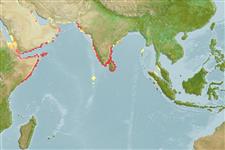Lớp phụ Cá sụn (cá mập và cá đuối) (sharks and rays) >
Myliobatiformes (Stingrays) >
Dasyatidae (Stingrays) > Urogymninae
Etymology: bineeshi: Named for Indian biologist K.K. Bineesh..
Environment: milieu / climate zone / depth range / distribution range
Sinh thái học
Biển gần đáy; Mức độ sâu 13 - 22 m (Ref. 110187). Tropical
Indian Ocean: Pakistan and India, Bay of Bengal; probably most widely distributed but its occurrence may be strongly habitat dependent.
Bộ gần gũi / Khối lượng (Trọng lượng) / Age
Maturity: Lm ? range ? - ? cm
Max length : 66.0 cm WD con đực/không giới tính; (Ref. 110187); 25.0 cm WD (female)
Short description
Hình thái học | Sinh trắc học
Động vật có xương sống: 108 - 114. This species (size at least 66 cm DW) is distinguished by the following set of characters: disc is weakly rhomboidal to suboval, its length 93-98% DW; snout is moderately elongate with weak apical lobe, snout angle 116-121°; pectoral-fin apices are broadly rounded; orbits small to medium-sized, barely protruding; relatively narrow mouth, its width 1.2-1.3 in internasal width; distance between first gill slits is 2.2-2.5 times internasal distance; distance between fifth gill slits is 1.4-1.6 times internasal distance, 28-30% of ventral head length; pelvic-fin base is broad, 14-15% DW; main suprascapular denticle is large, yellowish, broadly ovate, usually followed by smaller subtriangular denticle; secondary denticles developing rapidly, forming a broad band extending from interorbit to tail base by 24 cm DW; dorsal disc uniformly light brown, without white spots; pale ventrally with broad, faint and slightly darker lateral margins; tail dark brown to blackish dorsally and white ventrally forward of caudal sting; plain blackish posteriorly or with weak, irregular pale dorsal banding (in young); pectoral-fin radials 127-131; total vertebral count, 108-114, including synarcual centra, monospondylous centra 44-46, pre-sting diplospondylous centra 64-69 (Ref. 110187).
Smallest specimen, immature male at 20 cm WD is postnatal; birth size unknown, but probably ca. 15.0-17.0 cm WD (Ref. 110187).
Life cycle and mating behavior
Chín muồi sinh dục | Sự tái sinh sản | Đẻ trứng | Các trứng | Sự sinh sản | Ấu trùng
Manjaji-Matsumoto, B.M. and P.R. Last, 2016. Two new whiprays, Maculabatis arabica sp. nov. and M. bineeshi sp. nov. (Myliobatiformes: Dasyatidae), from the northern Indian Ocean. Zootaxa 4144(3):335-353. (Ref. 110187)
IUCN Red List Status (Ref. 130435)
Threat to humans
Harmless
Human uses
Thêm thông tin
Age/SizeSự sinh trưởngLength-weightLength-lengthLength-frequenciesSinh trắc họcHình thái họcẤu trùngSự biến động ấu trùngBổ xungSự phong phúBRUVS
Các tài liệu tham khảoNuôi trồng thủy sảnTổng quan nuôi trồng thủy sảnCác giốngDi truyềnElectrophoresesDi sảnCác bệnhChế biếnNutrientsMass conversion
Các công cụ
Special reports
Download XML
Các nguồn internet
Estimates based on models
Phylogenetic diversity index (Ref.
82804): PD
50 = 0.5078 [Uniqueness, from 0.5 = low to 2.0 = high].
Bayesian length-weight: a=0.01622 (0.00606 - 0.04338), b=3.00 (2.77 - 3.23), in cm total length, based on LWR estimates for this (Sub)family-body shape (Ref.
93245).
Mức dinh dưỡng (Ref.
69278): 3.7 ±0.4 se; based on size and trophs of closest relatives
Fishing Vulnerability (Ref.
59153): Very high vulnerability (90 of 100).
